Wagon Reviews
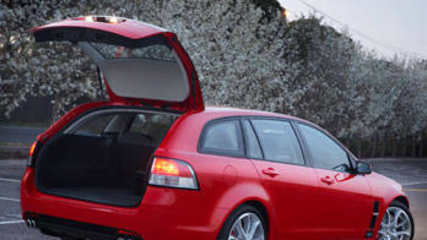
HSV Clubsport 2009 review
Read the article
By Stuart Martin · 19 Dec 2008
...and made some changes for the better with its range up date for 2009.The first HSV wagon since the Avalanche will be $1000 above its R8 sedan equivalent at $65,990 and available with the new six-speed manual or a re-calibrated six-speed automatic, which ups the pricetag ante to $68,320.The recalibrated auto and new Tremec TR6060 manual transmission are part of the MY9.5 HSV model upgrade, which also includes some engine recalibration.As is de-rigeur for the HSV models, there's a bit of a bodykit - focussed mainly on the nose and side skirts - with the rear remaining largely similar to the Sportwagon.Unlike the sedan variants, HSV has left the rear lights alone, something that would have cost $1.5 million to alter and the company is taking a measured approach to this wagon.The company will get just over 160 built but the orders already stretch well into the first quarter of 2009 - even HSV boss Phil Harding wants one, but he's waiting patiently for sales to be fulfilled first.The interior gets upgraded seats (full leather trimmed versions are $2490), a new rear seat, dual-zone climate control and also adopts the new white-faced instruments and centre-pod of gauges, which will go range-wide for 2009.The Tourer is also fitted standard with a reversing camera and rear park assist and gets a shorter final drive ratio.It sits on 19in wheels with 245/40 front and 275/35 rear rubber as standard, but can be optioned up to a 20in wheel with slightly lower profile tyres for $2500.The R8 Tourer is 20 per cent firmer in its suspension but has a reduced rear roll bar diameter.HSV chief engineer Joel Stoddart said the aim was to leave the wagon driver with the same wheel-time experience as that of a sedan."One of our main objectives when we decided to embark on this car was that the driver should lose nothing in the driving experience in this car over and above the sedan," he says.The suspension tune differs a little bit from its sedan sibling as the HSV engineers have tweaked a few things during the development - it's about 20 per cent stiffer all round, with the same rear dampers as the Maloo utility and a smaller-diameter rear anti-roll bar than the Clubsport R8.On the launch drive through the hills north-east of Melbourne, the first R8 Tourer sampled had the 20in wheel option, which gives the handsome wagon a more aggressive look.The company was working from a more-than-competent base with the Sportwagon and the suspension tweaks - with either wheel package bolted on - has only enhanced the drive experience.The tighter tune keeps the body under control but rolling (and oversteer) from the rear takes a lot more provocation before it becomes evident.For the driver, the addition of a new six-speed manual to the range almost overshadowed any other changes - while HSV says it's not a massive change from the old gearbox, the new six-speed is quicker and sharper to change, with better defined gates and a cleaner action.The six-speed auto also benefits from recalibration and the benefits are most felt in sport mode.It's not a hyper-aggressive alter-ego and seems to have a little more in the way of smarts on the way into corners under brakes.The addition of the camera makes parking and manoeuvring quite a bit easier - given the whopper D-pillars it probably should have been there from the get-go at Holden.For those shopping for load-luggers and/or kid carriers but not interest in SUVs, HSV has plenty to offer.In terms of performance wagons, they are few and far between that could match the R8 Tourer for pace, let alone on price - Audi has its $270,000 RS6, Benz has the $146,000 C63 and $239,000 E63 wagons.The R8 Tourer seems to have the versatility of a wagon and the performance and driving manners of a home-grown hotrod sedan.
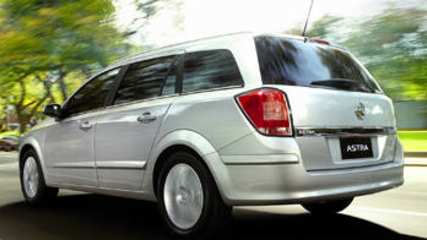
Holden Astra 2008 review
Read the article
By Jonah Wigley · 11 Dec 2008
The Astra Diesel wagon runs on a 1.9 litre, DT Turbo Diesel, SOHC, ECOTEC four cylinder engine that outputs 88kW at 3500-4000rpm and 280Nm at 2000-2750rpm.A six speed automatic with Active Select gets power to the wheels. And as you’d expect, fuel economy is reasonable at 7.3 litres per 100 kilometres.Compact yet roomy, the Astra wagon is a viable option for those who need a large cargo area but don’t want the hassle of a bulky van or large station wagon and the associated running costs. With a long rising waistband, the wagon is basically a stretched version of the hatch and comes with 16-inch alloys as standard.The fully carpeted 454 litre load area is expandable to 1549 litres with both 60/40 split rear seats folded flat. As standard, the Astra wagon comes with a multi-function display, an MP3 compatible audio system, power windows and mirrors and cruise control.A comprehensive safety package comprises curtain, drive, front passenger and front side impact airbags, plus brake assist, remote central locking and Electronic Stability Program.Pricing for the Astra Diesel wagon starts at $32, 790.That fact that Holden have so few details of the exterior on the website speaks volumes about how much effort they put into the Astra wagon design. It’s a box on wheels, plain and simple – and a tinny looking one at that.Stepping into the car our spirits didn’t lift. The bleak black dash is like a wall of drear, helped not at all by the quality of plastics used to build it. And because it’s as flat as a cliff face, and because the gear lever sits so low, it opens up a cavernous unusable space that made us feel somehow a little exposed.But this car was built for its practicality, not for its beauty. It’s fairly spacious, and the seats are comfortable and smart, so we erase our poor initial impressions and fire up the engine – prompting the passengers to get out and scour the exterior for a John Deere badge. Old unmufflered tractors could be quieter than this. And for a car this small, the noise is laughable.On the road the diesel engine does have quite a surprising amount of poke and the suspension is comfortable although the transmission tends to get a little confused when we sped up or slowed too quickly.Holding the wheel at a quarter to three was slightly painful after a while with a sharp bit of plastic sticking up right where the thumb rests. The side mirrors were equally as irritating with the ‘objects in the mirror are closer than they appear’ distortion more confusing than helpful.But again, this is meant to be a basic, economical A-to-B car with a big cargo area and it serves that purpose adequately.
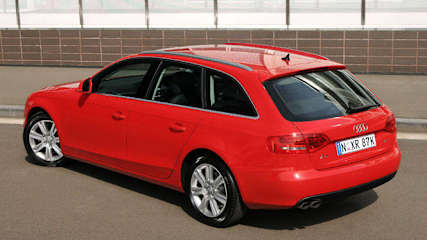
Audi A4 2008 review
Read the article
By Neil Dowling · 09 Dec 2008
Station wagons are for wet labradors, muddy mountain bikes, prams and potted plants.If you don't own any of these, you have no reason to drive a station wagon and should at all costs bypass these at the showroom.Or so I thought. Yes, I have memories of holidays as a child in a station wagon.But they were days when the car was a cubby house — place to be filled with movement and toys and open windows and no seatbelts.We never whinged "Are we there yet?" because there was so much to do in the expanse of the station wagon.Our children know of no such joys. Today the ankle-biters are locked into position and would go completely troppo — and take their parents with them — save for the blessings of rear DVD players and iPods.Audi looks after its rear occupants with the option of such attention-grabbing aids but the kids aren't reading this so I'm going to list what's in it for you.PackageThe Audi A4 as already been lauded as a beaut sedan. This Avant (read, wagon) just adds flexibility though can also become quite unwagon-like thanks to a stylish upgrade.The S-Line package adds exterior features that are subtle enough to escape the garishness of some manufacturers' examples, yet strong enough to enhance an already neat wagon.Colour is important. The white A4 Avant is stunning in its simplicity and gets a lift with polished 18-inch alloy five-spoke wheels.S-Line packages also trim 20mm from the standard A4's height and sits the car on sports suspension. And here is one of the car's few hiccups.The ride is a tad too firm for a vehicle ostensibly meant for leisure-seeking families rather than race-bred couples.That's not helped by the leather upholstery stretched over hard foam. Great for distance driving but it takes a bit to get used to in the suburbs.Yet, if you revert to the standard 16-inch wheels to retrieve Japanese levels of comfort, the wagon ends up looking like Mum's taxi.DrivetrainInto the mix we add Audi's perennial 2-litre turbo-diesel and a CVT automatic transmission.This transmission also has seven preset ratios so, thanks to one of the items in the S-Line pack, you can drive it like a clutchless manual.The engine is a real trouper that pulls hard and clean from virtually any revs, has a real kick when asked to overtake slower traffic and delivers fuel economy that'll make your wallet obsolete. Well, not quite.It's a package that, because the world turns faster than we can anticipate, was even more attractive about six months ago.Subsequently, the world oil price has halved and this made a dramatic 30c a litre drop — any discrepancy here? — in the bowser price of petrol. Unfortunately, the impact on diesel prices was even less miniscular.That makes buying a diesel — especially where the engine price is a premium — suit only the bearded eco-aware folk in the mountains and motorists who annually travel long distances.You must today weigh up if a diesel makes economical sense to you. Otherwise, the Audi A4 Avant petrol ($59,641 in equivalent S-Line format) may make more sense.SafetyThe A4 Avant scores very highly on safety but the most impressive feature of the car is its quality. Few, if any, manufacturers consistently make such near-perfect machines that are so visually impressive.DrivingThis wagon is dead simple to drive — though I was baulked by the fingernail-breaking push-pull design of the starter — and is compact enough to slip quickly into a crowded parking bay.It seats four adults with cargo impressively increased thanks to the near-flat folding rear seats. The spare wheel is a space saver and there's no excuse.As fitted out for this test, the Avant is a wagon that rises out of the family-car image to be stylish and versatile.And if you really, really must, it will take muddied dogs, bikes and pot plants. And prams. SnapshotPrice: $57,837 (S-Line as tested $66,205)Engine: 2-litre, 4-cyl, turbocharger, intercoolerPower: 105kW @ 4200rpmTorque: 320Nm @ 1750-2500rpmTransmission: CVT with 7-preset ratios, sequential; front-drive0-100km/h: 9.7 secondsEconomy (official): 6.0 litres/100kmEconomy (tested): 6.8 litres/100kmGreenhouse: 159g/km (Corolla: 175g/km)

Audi RS6 2008 review
Read the article
By Neil McDonald · 30 Oct 2008
BMW might like to disagree, given its V10 M5, but it's hard to disagree with Audi when you look at the spec sheet that includes a twin-turbo V10 engine, quattro all-wheel drive and Audi's dynamic ride control suspension.The RS6's 5.0-litre V10 engine also packs a considerable punch, with 426kW and 650Nm.Like all Audi RS models, the Avant _ Audi speak for station wagon _ was developed by quattro GmbH.It will cost $270,946 when it hits local showrooms next month.An RS6 sedan will follow early next year.The newest RS6 Avant comes with a long heritage attached to it.The very first Audi RS2, launched in 1993, was built exclusively as a wagon.With 1660 litres of luggage space, not only is the newest Avant versatile but it will challenge its fellow German rivals for power and performance.The 5.0-litre V10, sourced from Lamborghini but reworked by Audi, bundles together FSI direct fuel injection, dry-sump lubrication and twin turbochargers.With up to 1.6 bar of boost, these technologies provide a smooth delivery of power and performance.Peak torque of 650Nm comes in from 1500 to 6250 revs while peak power of 426kW is generated between 6250 and 6700 revs.The V10 catapults the car to 100 km/h in 4.6 seconds and has an electronically-limited top speed of 250 km/h.Power flows through the new-generation quick shifting six-speed tiptronic transmission with paddle shifters.The dynamic ride control has three damper settings, sport, dynamic and comfort and also reduces pitch and roll using purely mechanical means via hydraulic lines and valves that connect diagonally to opposing pairs of shock absorbers.When cornering, the flow of fluid to the damper of the compressing outside front wheel increases, providing firmer support and reducing roll.The electronic stability control has a higher activation threshold and in Sport mode it can also be deactivated entirely.The Avant gets 20-inch alloys shod with 275/35 tyres.Up front, six-piston fixed aluminium calipers, painted black and decorated with RS badges, clamp down on 390mm brakes front and 356mm rear.The rear axle features single-piston floating brake calipers.The brakes have large cooling ducts and axial perforations for enhanced performance and less weight.Visually the Avant sports several distinctive RS features.There is the single-frame grille, large air intakes, Xenon-plus headlights, adaptive light and LED daytime running lights, flared mudguards and deep side skirts, rear diffuser, a spoiler integrated into the rear hatch and the twin exhausts.Standard equipment includes a colour monitor and TV reception, advanced key entry, electric glass sunroof, satellite navigation, dual-zone deluxe automatic air conditioning plus, front and rear parking sensors, three-spoke, multi-function leather sports steering wheel with flat-bottomed rim and a Bose surround sound system.A boost pressure indicator for the two turbochargers in the driver information system rounds out the instrumentation.

Skoda Octavia 2008 review
Read the article
By Staff Writers · 30 Oct 2008
The Czech-built Octavia RS has been enlivened with a new diesel engine.Engines Until now, the sports orientated RS lift back and wagon only came packing a turbocharged 2-litre 147kW four-cylinder petrol motor, combined with a six-speed manual transmission .That's all about the change.Buyers looking at reducing their fuel bill can now opt for a performance-orientated Octavia RS TDi with a frugal 2-litre common rail turbo diesel - coming from Skoda's parent, Volkswagen which has also fitted it, in various states of tune, to the Tiguan, Golf, Passat and Jetta.In the Golf it develops 103kW, but in the Octavia RS there's a much healthier 125kW to play with and as such is the most powerful diesel offered by Skoda to date. There's a choice of a six-speed manual or for the first time, an optional six-speed VW sourced dual clutch `manu-matic’ (DSG) - something we have already seen throughout the VW family.From February, the automatic DSG will also be offered in the petrol RS; the 2009 update for both petrol and diesel models also brings audio controls and paddle shifting on the steering wheel.Styling It's not all good news though: the bland styling of the RS Octavia is now four years old and it shows, but it's Down Under duty has been extended by Skoda until the third quarter of next year when it will be replaced with a heavily face lifted version showing a much stronger styling to match its sporty persona.Transmissions While future bread and butter Octavia models will next year feature a seven-speed DSG, the RS will retain the six-speeder because the seven wasn't designed for a high torque engine.Pricing The diesel version of RS went on sale this week, sharply priced at $39,490 for the manual lift back and $41,790 for the DSG manual/auto. That's a $2000 premium over the petrol version. The diesel wagon starts at $41,490, with the DSG priced at $43,790.Equipment Standard kit on the diesel RS includes lowered suspension with stiffer spring ratings, stability control, 18-inch alloys, boot spoiler, sports seats and pedals, three-spoke leather steering wheel and go-fast looking red-painted brake calipers.Safety Safety gear includes six airbags, active front head rests, anti lock brakes with electronic brake pressure distribution and traction control.DRIVING A few years ago, if you mentioned the words `diesel’ and `sports’ in the same sentence people thought you were, well, balmy.But as a succession of European brands has shown in more recent times you can successfully marry an oil burner with enough performance to raise your blood pressure. Call it the smile factor, and Skoda's RS TDi leaves you grinning.The stop watch aptly tells the story here; the 2-litre diesel, at 8.4 seconds, is just 1.1 seconds slower from zero to 100km/h than its 2-litre turbo petrol RS cousin; not shabby at all considering acceleration from a standing start has traditionally been a diesel's downfall. Remarkably, if you believe Skoda's specification list, the diesel mysteriously weighs up to 40kg less than the petrol version which may explain why the sprint times are so close.OK, the petrol engine does win out on terminal speed at 240km/h against the diesel's mere 225km/h but, as any copper will tell you, that's an irrelevant yardstick nowadays.Where the diesel excels - and should appeal to green-at-heart family buyers - is on fuel economy and exhaust emissions: the diesel is rated at 5.9l/100km; the petrol can only manage 8.1l/100km. The diesel, thanks to its particulate filter is cleaner too, producing 155g of CO2 at the tailpipe per kilometre; the petrol is rated at 193g/km.But stat sheets are one thing; driving the RS TDi is another and, not surprisingly, it doesn't disappoint, on both the road and racetrack.Adding common rail technology to the new engine (instead of the single point Pumpe Duse system in the old engine) has substantially reduced noise and vibration levels to a point, at times, you have to think whether you are driving a diesel or petrol. Looking for a badge on the boot won't help either - there's nothing to tell the diesel from the petrol apart from engine noise at idle.The diesel still shows a lot of turbo lag which is annoying if you want to press on, and there's a degree of predictable understeer to contend from this front wheeler with a lot of weight over its front axle. But the RS shows a wonderfully balanced chassis and refinement which adds to the driving enjoyment.The RS doesn't provide wild child performance; but it will satisfy most drivers. It's a solid, quality built car offering plenty of value for money.What the RS lacks is a styling package which has the ability to turn heads - painting the brake calipers bright red and adding a mild aero kit doesn't cut it - which neatly sums up Skoda's problems in getting attention in this country as it tries to reestablish the brand.
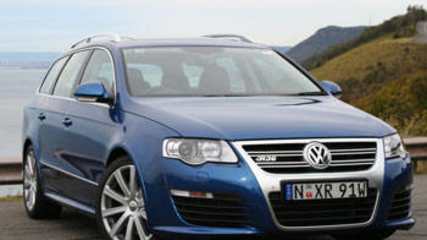
Volkswagen Passat R36 2008 review
Read the article
By Paul Pottinger · 13 Oct 2008
You take an unassuming passenger car, harden up its drivetrain and ramp up performance. You add visual appeal with go fast bits and badges. And you wind up with an embellished shopping trolley or worse, you get a crass dork in a bad suit; like the TRD Aurion.So why does the latest edition of Volkswagen's R series convince in a way that the models preceding it in the distinctively deep blue paint and chrome grille haven't? If the Passat R36 followed the form book, we'd be saying the currently top whack Passat sits too close for the R version to offer sufficient reason to spend the extra thousands.And for what, exactly? Both cars have part-time all-wheel-drive, twin clutch gearbox and a direct injection V6, it's just that the R engine has 400cc more.Somehow though, the R car, at least in the wagon form we sampled, does it in a way the other Rs don't. It helps not a little that the regular Passat is visually anonymous, so the blue paint and shiny bits at least make it less indistinct. As does the interior statement, with suede-like inners on the leather seats and a lovely, fist-filling steering wheel.While calling it the “sportiest Passat of all time” is a bit like claiming to be the fittest player at the local bowling club, the R36 has the output and performance figures to make it quite the Wolfsburger in chic clothing. On the whole this fitness is wasted in a country without autobahns. Still, the 220kW/350Nm on tap can shove this near 1.8-tonner from standing to 100km/h in less than six seconds.Unlike the 3.2 V6 in the regular Passat, that torque arrives later in the piece, making this an engine to rev and it goes appreciably harder to towards to the top of the rev range.DSG has never captivated us to the extent it has many of our fellow hacks, being as ever apt to over-ride your gear selections even in manual or sport mode. Best leave it in Drive, where it's an adroit conductor. You can always effect temporary manual over-ride, using the left paddle shifter to engine brake, shortly after which it resumes automatic mode.Essentially the R36 is a big, secure cruiser, entering a corner like the powerful front driver it essentially is, transferring torque to the back axle via the Haldex coupling. Feel through the wheel is adequate, if muted, the position from which you command it is excellent.The assertiveness and composure with which it shoots out of the bend is abetted by the sonorous note of an engine that's more usually found in VW Group SUVs and Porsche's Cayenne.That's just one reason why this cargo carrying R car kills off any logical reason to go down the Touareg route.The other is monumental cargo capacity (near enough 1800 litres with the back seats flat).The weekend excursion from the city really is the R36's milieu.Because, although the ride on anything but the smoothest blacktop is terse, even irritating, this is a car capable of dispatching family business in comfort while imbuing the ageing chap behind the wheel with at least the notional ability to step over obnoxious youths in their thrusty rice rockets.It's that breadth of ability which makes this R car that bit special. Bottom LineVolkswagen's only current R edition that justifies the spend.
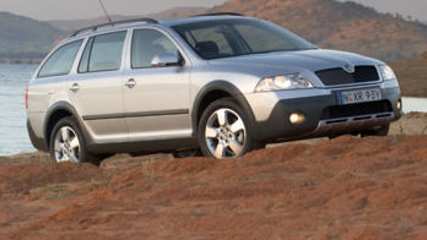
Skoda Octavia Scout 2008 Review
Read the article
By Derek Ogden · 25 Sep 2008
Be prepared: it's the motto of the Scouting movement and could just as easily be applied to the Scout, Skoda's entry into the compact sports utility vehicle market.Based on the Octavia 4x4 wagon, the Scout is aimed at those who want a refined yet rugged vehicle with the practicality of a station wagon. That is, a model that is prepared for almost anything.The Octavia Scout 4x4 has been developed to be as happy on the street as it is in mud, sand, snow, or on gravel.Key to this flexibility lies in its second-generation Haldex clutch, which allows power to be transferred between the front and rear wheels when it is required, reacting faster than the first generation mechanism giving better traction on loose surfaces.And with 180mm ground clearance and 17in Proteus alloy wheels, there's little terrain that can stop it in its tracks.Power to the wheels comes from the tried and tested Volkswagen 2 litre TDI turbo-diesel engine with particulate filter as standard producing 103kW of power and 320Nm of torque via a six-speed manual transmission.Acceleration from zero to 100km/h is a claimed 10.2 seconds, with a top speed of 197km/h.The Scout is said to use 6.6 litres of fuel per 100km (43 miles per gallon) on the combined urban/highway cycle from a 60 litre tank and put out 178g of carbon dioxide per kilometre.It will tow a trailer with brakes up to 1600kg, 650kg without.At 4581mm, the Scout is 9mm longer than the standard Octavia 4x4 wagon and is 15mm wider and 17mm higher at 180mm, making the ground clearance 40mm greater than the two-wheel drive Octavia.It also looks very different from its sibling with chunky bumpers at the front and rear, moulded side protective strips and profiled door sills, all giving greater protection for the bodywork.Black roof rails reinforce the practical nature of the vehicle, as do circular fog lamps below the headlights.Protective wheel-arch strips, unique kick plates on the front door sills and sump guards below the front and rear bumpers are all standard. A four-spoke multifunction steering wheel, gear lever and handbrake are trimmed in leather, while special seat fabric and a grab handle on the dashboard ahead of the passenger seat are unique to the SUV.The wagon gets a swag of standard equipment including heated front seats, dual zone air-con, electronic stability control, six airbags, rear acoustic parking sensors, cruise control, twin chrome exhausts and unique Scout touches throughout the cabin.And the generous 580 litres of rear cargo space can be increased to 1620 litres with both back seats folded flat.Cargo can be anchored down by means of an expandable net and a privacy cover retracts at a single touch.During a drive in the Victorian Alps over bitumen, gravel and in mud, the Scout proved to be all it claimed and more.As well as producing a comfortable ride under sometimes trying conditions, the car never once lost its footing.The cabin was welcoming and quiet, with little intrusive engine sound, and minimal road and wind noise even at the legal speed limit.Altogether it's a surprisingly functional and smart package which, at a starting price of $39,990, takes it right up to rivals for value and versatility.Options include Columbus satellite navigation ($2490) and the usual additions such as sunroof ($1730) Alacantara and leather seats ($2490), xenon headlights ($1730) and front park distance control ($490).The Scout could suffer some initial sales resistance due to the fact there is no automatic gearbox on offer.But it is already on a winner with former world surfing champion and Gold Coast resident Mark Ochilupo about to take delivery of one as a Skoda ambassador.
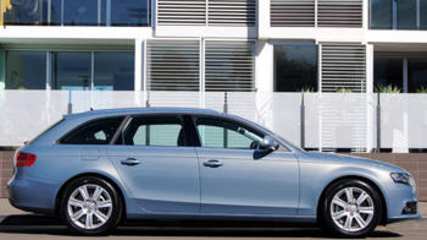
Audi A4 2008 review
Read the article
By Paul Pottinger · 12 Sep 2008
The Avant variant (that'd be wagon to us Strayans) of the well-received A4 sedan range arrived last week and were launched last week with a testing drive out of Albury to Bright in the Victorian high country and back.As with most Euro prestige wagons, a genre becoming ever more evident on our roads, it's not as though the Avants are a great deal more practical than the sedan, which boasts quite a big booty. Rather it's a question of which flicks your switch aesthetically.Still, the five door does have a highly useable 490 litres with the back seats up and 1430 when they’re folded flat. Up front there's a choice of the Volkswagen Group's direct injection turbo charged four cylinder engines. These are the stalwart 2.0-litre TDI common rail diesel and _ one of our favourite small petrol jobbies _ the 1.8 TFSI.Both versions are driven through the front wheels via Audi's Multitronic continuously variable transmission with eight manual settings. Down the line, perhaps the second quarter of 2009, comes the enticing prospect of a quattro all-wheel-drive variant with a 155kW/350Nm version of the 2.0-litre turbo four, a drivetrain that will also go to the four door.Like the current four door, the Avant has a decent levels of standard equipment and the usual mile long list of costly extras. The pretty much standard 1.8 version we drove to Bright featured Milano leather upholstery, Servotronic steering, eight airbags, daytime running lights and $1600(!) metallic paint. The S-line packaged version in which we returned also copped grippy great 18-inch low profile rubber, paddle shifters, perforated leather and the optimum version of Drive Select (through which steering, gearshift and damping responses are altered to mood or circumstance).Even without the full length sun roof ($2850), this variant returned little change from $70K. Steep, even when placed next to the Audi's direct rivals, BMW's 320i Touring and the Mercedes-Benz 200K Estate. And not a little silly if you're not so hopelessly badge besotted that you can't see the merits of Skoda's Octavia (with the same engines) and the Mazda6.Both are equally good if not better drives, both are bigger and both are $25,000 to $35,000 cheaper. We could also point to Holden's new Commdore sportwagon, but badge blindness goes only so far.As opposed to the previous generation A4, the new Audi is an attractive proposition as much for its on road behaviour as its chic lines. We'll get to the diesel in coming weeks (it's anticipated take up rate is less than 20 per cent), but on the word of trusted colleagues it reflects the equivalent sedan's disposition.That's to say that the extra weight, especially over the front axle, drags it back against its more adroit petrol sibling. Audi's persistence with longitudinal engines means that the bigger the donk the more negated the advantages of its much-vaunted new platform.Nor can a decisive economy advantage be claimed for the oiler. When pushing on, it needs to be spurred. In city traffic its consumption approaches that of the petrol car.In fact, the 1.8 TFSI combines the best characteristics of petrol and diesel, with the flexibility of the former (at 8.9 seconds it's almost one tick quicker to 100km/h from standing) and the low down response of the latter. And all of its 250Nm is available from 1500rpm _ almost the instant the throttle is floored.It's a light weight contender that punches above its weight to imbue the Avant with a dynamic behaviour that's about as rewarding as you're going to get in a front-wheel-drive. While never enamoured of CVT, there are few grounds to complain of the way in which it transmits power to the road.As ever with Audi, the inside story is one of tactile delight. The interior of even a basic spec variant is pervaded by an air of comfort, convenience and sheer quality that exceeds the Merc and leaves the Bimmer for dead.When you're sitting this prettily, you don't mind so much which wheels are doing the driving. AUDI A4 AVANTprice: $56,400 (TFSI); $57,800 (TDI)engines: 1.8L/4-cylinder turbo petrol (118kW/250Nm); 2L/4-cylinder turbo diesel (105kW/320Nm)economy: 7.4L/100km (TFSI); 6L/100km (TDI)transmission: continuously variable auto

Mercedes C-Class 2008 Review
Read the article
By Jonah Wigley · 09 Sep 2008
Engine and TransmissionThe estate uses the same engine that powers its saloon sibling -- a super-charged four-cylinder engine that puts out 135kW and 250Nm, with power getting to the wheels via a five-speed automatic with paddle shifts on the steering wheel..Fitted with improved pistons and with modified engine management, the C200 estate boasts impressive performance and fuel consumption at 8.3litres/100kms.ExteriorThe giant German marque has made sure to hold on to the distinctive Mercedes-Benz characteristics with C200 estate, whilst adding modern elements.The distinctive chrome three-louvered radiator grille and big centred badge plus chrome highlights on the bumpers, wings and doors help to retain the classic Merc presence. The body coloured bumpers, polished aluminium roof rails, an electric glass sun-roof and 17 inch, five twin-spoke, light-alloy wheels give it an edgy modern feel.The side profile highlights a creased waistline following the long rise from the bonnet, over the windscreen then gently down to the top of the tail gate where it drops abruptly and folds into a short rear overhang. The front wheels being pushed right to the front also give the car an athletic, purposeful stance.InteriorInside, the C200 has a sporty flavour with black floor mats and dash, contrasting with the door panels and arm rests in reef grey. The classic Merc heritage is never too far away though, highlighted by black bird’s eye maple and full leather upholstery.As always, quality and attention to detail is easily evident. Electronically adjustable driver and passenger seats with memory settings, three-zone automatic climate control, a Harmon/Kardon Logic 7 sound system and voice recognition functionality are all standard.SafetyFront airbags, window bags and side bags for the driver and front passenger plus window bags and side bags for the side passenger, together with Adaptive Brake Regulation with hillstart assist, ESP, ABS, crash-responsive active head restraints(for front seats) and a tyre pressure loss warning system, completes the substantial safety package.PricingThe C200 estate starts at $58,978.DRIVINGWigley saysAfter recently driving the C63 AMG I was a little apprehensive stepping into the standard wagon because I almost know I’d be let down. But I really wasn’t.Both cars are great in their own ways – the C63 is a performance powerhouse and the estate is a comfortable, refined family wagon – and a damn good one at that.The workmanship and quality of the interior as always is first class. Initially the seats felt a little small but I soon sunk into them and felt completely supported.The flat bottom boot fits a lot but the car itself looks compact from the outside.The revised suspension, especially with the three settings made driving a joy in all conditions.Power, although not mind numbingly raucous, was sufficient enough to be able to merge and overtake without a trickle of fear that you might get rammed.The one gripe I had was the legroom in the back seats. Even with the front seats forward, the back is only really big enough for two mid-sized teenages.Verdict: 8/10Halligan saysI am a big fan of the current C-Class. The C200 wagon reaffirms this opinion once again. It's a great package and it just feels right when you drive it.It has ample power for its target market. Style, presence, quality and performance are all excellent and I only have one criticism of the C-Class in general. It needs just an extra couple of centimetres between the front and rear seats.While I am not a fan of models growing through their life cycle, I think the C can afford to do so. At the moment it is still virtually the same size as the first generation 190 I parked it beside in the family garage.Start-up families shopping in this price bracket should consider this car. Don't do the normal thing and buy a mid-size 4x4 without first looking at one of these. Do your sums and consider cost of ownership and depreciation. Service costs, tyres and depreciation on most mid 4x4 is ludicrous especially in this price range.Quality, presence and style. More people should consider one.Verdict: 8.2/10
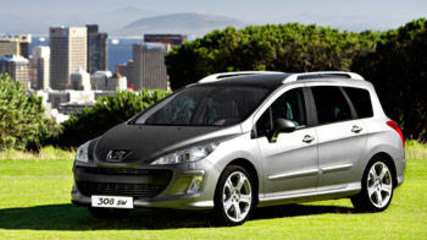
Peugeot 308 Touring wagon 2008 review
Read the article
By Paul Gover · 22 Aug 2008
The French company's sales are down by close to 20 per cent at a time when the rest of the car business, until this month, has been doing very nicely.Peugeot puts its troubles down to the transition to the all-new compact 308 and says the arrival of the Touring wagon, which will be joined by its 308CC before the end of the year, will turn things around.It also believes its new Expert and Partner vans, which landed as the same time as the Touring, will give it a much-needed boost on the commercial front.“It's been a tough year for us. However, I think running out the 307 is well behind us and we can make up lost ground with the 308,” says Ken Thomas, national sales manager for Peugeot.“We're going to capitalise on the strong reputation we have built in the small wagon market. It's an important launch for this brand. Its got great styling, technology and unique features, with up to seven seats and a full glass roof.”The 308 Touring is more like an oversized hatchback than a tradition wagon, so in some ways it is similar to the new Holden Commodore Sportwagon. But the Peugeot is uniquely French, from its good looks to an emphasis on the diesel engine which is expected to draw the majority of sales.The objective is to sell more than 1000 wagons before the end of the year, and closer to 1900 in 2009, as Peugeot aims to hit 9000 total sales for '08.The Touring package is priced from $30,590, with a choice of two trim levels, four engines — two diesel, two petrol — and both automatic and manual gearboxes with front-wheel drive. The specification is pretty comprehensive, although ESP stability control is only an option on the basic CS model.The Touring is based on the latest 308 mechanical package, which means fully independent suspension, four-wheel disc brakes and a safety package including six airbags and anti-skid brakes with brake assist and a system which triggers the hazard lights in extreme braking.The XS opens the action with air-con, cruise control, remote central locking and the full-length glass sunroof, while the XSE tips in ESP, rear parking radar, alloy wheels, and rain-sensing wipers. Leather seats and a multi-media sound system are optional.The four-cylinder engines are 88 and 103 kiloWatt petrol motors, which Peugeot calls VTi and THP for the turbo, and 80 and 100 kiloWatt diesels. There is a six-speed manual for all engines, but the automatic is only a four-speed on the petrol engines, upgrading to a six on the diesels.Peugeot does all its comparisons against the outgoing 307, talking up the increased rigidity of the new body as well as a bigger boot and more cabin space.But the bottom line on a wagon is the seating and space. The Touring has 'theatre' seats, with tiered settings to improve visibility and reduce the chance of a car sick child, although the third-row lineup is only called 'occasional' and there are a huge number of storage choices.“There are seven seats and they are plug-and-play. You can move them around and there are a huge number of combinations,” says Peugeot's Glenn Forester.The 308 Touring is everything you expect of a Peugeot. It looks good, is very comfortable, there is a lot of creative thinking, and it drives well.The 2-litre petrol model gets along well and has a responsive gearbox, although the 1.6 is likely to struggle particularly with a family load. The 2-litre diesel is responsive and works well with either manual or automatic gearbox.The diesel also shows Peugeot's class and experience, as it is extremely quiet at both start-up and highway cruising speeds.The cabin is roomy for the class, the seats are comfy and supportive, and the equipment is everything you would want or need — apart from ESP on the base car.The flexibility is excellent and you can mix-and-match the seats, or remove some completely, depending on your needs. It takes a bit of learning but is very worthwhile and advance over other compact wagons we have driven.The panoramic sunroof is a nice touch and will definitely get people looking, but also has a proper sun-blocker for hot weather.Peugeot deserves to do well with the Touring but needs to make more noise to get back on shopping lists in Australia, instead of relying on repeat business from existing owners.




